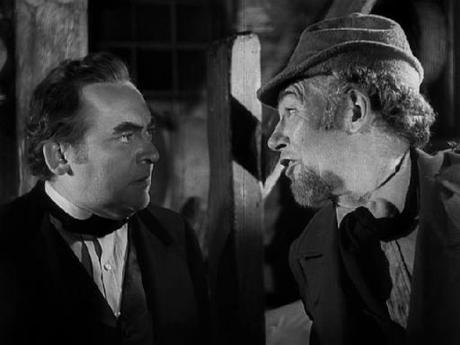 Daniel Webster (Edward Arnold) bargains with Mr. Scratch (Walter Huston) in William Dieterle’s The Devil and Daniel Webster (1941)
Daniel Webster (Edward Arnold) bargains with Mr. Scratch (Walter Huston) in William Dieterle’s The Devil and Daniel Webster (1941)The Wages of Sin
Selling one’s soul for material gain, of course, is an age-old and thrice familiar routine. Derived primarily from myths and legends, one can go back to medieval times to its roots — to the story of the real life Dr. Johannes Georg Faust selling his soul to Satan for fame, fortune and youth. (Let’s not forget sex, drugs and rock-n-roll, but not necessarily in that order.)
This so-called Dr. Faust lived and died in-and-around old Württemberg in Lutheran-era Germany. He was known variously and throughout the realm as a magus, an alchemist, a practical joker, and “a conjurer of cheap tricks” (as well as a bugger of young boys). These activities gave rise to the notion that Faust had made a blasphemous deal with the Devil in exchange for his “magical” abilities.
Indeed, the personage of Faust and his diabolical pact have been a recurring theme in literature and folklore long before it dawned on playwrights and poets to devote full-length stage treatments to the matter. Of course, the film and opera worlds were no strangers to the tale, for Faust was the protagonist in any number of lyric and/or cinematic ventures almost as frequent as that of Orpheus and his myth.
In point of fact, we can trace the development of the Faust legend (and its resultant tragic consequences) to the Biblical Book of Genesis — specifically, to the cautionary example of Adam and Eve. In this early telling, the first Man and Woman share a communal lifestyle in the bountiful Garden of Eden (or Paradise, to use the more descriptive term). Naked and unafraid, the couple roams the primeval forest, blissfully unaware of their nakedness yet profoundly cognizant of their pleasurable surroundings.

Tempted by the Serpent (the Devil in reptilian guise), they partake of the Forbidden Fruit of the Tree of the Knowledge of Good and Evil, the first recorded evidence of a quid pro quo: you do something for me, and I’ll do something for you (I’ll bet!).
As a result of her indulgence, Eve gets a tantalizing taste of the “good life” — not that it wasn’t good beforehand, but her act of defiance against God’s orders can be summed up in one apocryphal phrase: the Devil made her do it.
Eve shares the apple (or whatever fruit it happened to be) with her mate, Adam. Before long their eyes are opened to their own nude forms. They were ashamed, or so the Bible tells us, and thus sin came into the world.
One of the few motion-picture illustrations of this passage comes from the John Huston-directed, Dino De Laurentiis-produced three-hour extravaganza The Bible: In the Beginning (1966), with an athletically sculpted Michael Parks as Adam and Swedish actress Ulla Bergryd as Eve. The screenplay was credited to British author and playwright Christopher Fry, as if the poetry and high-mindedness of the King James Version needed further backing.
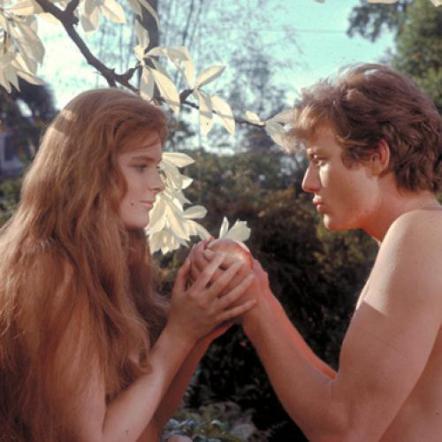
Blond, bland and bashful to a fault, both Parks and Bergryd are oh-so-beautiful to look at, but were no match for the slimy, sinuous Serpent — voiced to an insinuatingly deceitful degree by that old ham Huston. It should be noted that character and voiceover actor Sterling Holloway did similar vocal duties (to comparable if less successful effect) as Kaa the Snake in Disney’s animated feature Jungle Book from 1967. Only from Kaa’s part, it was mostly to engorge himself on the boy Mowgli’s flesh.
Faustian Bargains
The sale of one’s soul for untold riches and indescribable pleasures is explored in several film adaptations, among them F.W. Murnau’s silent version of Faust: A German Folktale (1926), which featured an international array of artists headed by Swedish actor Gösta Ekman as Faust, American Camilla Horn as Gretchen (Marguerite in Charles Gounod’s opera), and Swiss-born thespian Emil Jannings (The Blue Angel) as the highly effective Mephistopheles. Cineaste magazine described Jannings’ “glowing-eyed demon” as a “malevolent conniver with a touch of Benito Mussolini in his burly face.” Evviva Il Duce!
The film exists in many versions and in several foreign languages, as was the custom in the silent cinema and in the early days of sound. A compilation of Goethe’s dramatic play in two parts, it also encapsulates portions of Gounod’s operatic treatment, which concentrates on the alleged love story between Faust and the beautiful country girl Marguerite.
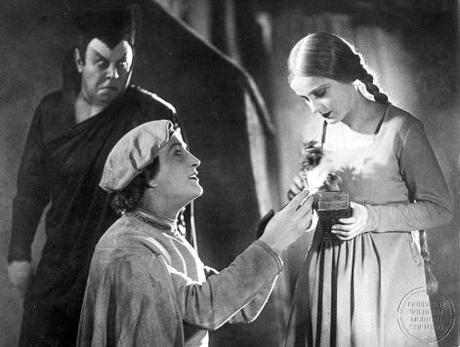
In one derided ending to Murnau’s picture, Gretchen is burned at the stake for deliberately drowning her illegitimate daughter fathered by the lustful Faust. Reverting to his actual old-man guise, Faust joins Gretchen in the hellish flames, only to be lifted upward, body and soul, to heaven in what has been termed “a visual effect of truly awesome tackiness.”
William Dieterle, who appeared as Gretchen’s warlike brother Valentin in Murnau’s flick, went on to direct a Faustian feature of his own. Known by various titles as The Devil and Daniel Webster, Daniel and the Devil, All That Money Can Buy, Mr. Scratch and Here Is a Man, this 1941 fantasy noir epic, adapted by poet and author Stephen Vincent Benét with screenwriter Dan Totheroh from Benét’s short story, The Devil and Daniel Webster, tells of a dirt poor New Hampshire farmer named Jabez Stone (James Craig).
Down on his luck and faced with foreclosure on his farm’s mortgage, Stone, as most fellows in his shoes would do in such dramatic circumstances, swears to sell his soul to the devil for a mere two cents’ worth of aid. No sooner does he say this when who should appear but the Devil himself, who answers to the name of Mr. Scratch. He’s played by a lanky Walter Huston, father of director John Huston and a notable stage and screen actor in his own right.
With an impish twinkle in his eye and equally wicked grin, Mr. Scratch sports chin whiskers and a fine rustic cap that give him the appearance of an iniquitous Robin Hood on the wrong side of the law. Scratch lures the unsuspecting Stone into his trap with gold coins that mysteriously materialize from his basement. After seven years of good fortune and several instances of deteriorating behavior on the part of Stone’s character — helped, in large measure, by the feminine wiles of tantalizing servant girl Simone Simon — Scratch comes back to make good on his pact.
At the end of his rope, Stone turns to the renowned orator and politician Daniel Webster (excellently portrayed by character actor Edward Arnold) to plead his case to an infernal jury of his peers. And what a jury it is, comprised of the worst traitors and evil-doers this side of Stephen Sondheim’s Assassins: “Americans all,” according to the jocular Scratch. In order to defend Stone against this deliberately stacked deck, Webster is forced to put up his own soul in exchange for his client’s release.
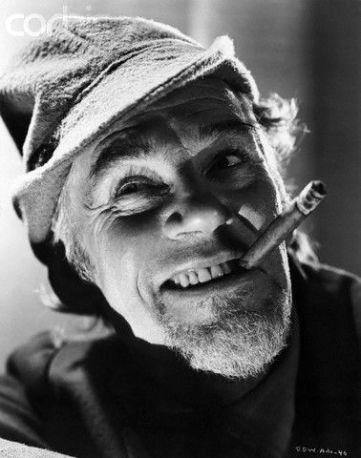
In the grand finale, the great orator manages to sway the jury to Stone’s side, thus cementing Webster’s reputation as a literal man of his word. The picture concludes with a typically Brechtian twist worthy of Pirandello: Scratch looks straight into the camera (and out to the audience) for potential candidates to corrupt.
To counteract the feelings of déjà vu that either of these features may have engendered in viewers, we bring you 1967’s Bedazzled, a satiric Swinging Sixties twist on the fable that takes place in a very Merry Ole England.
Directed and produced by Stanley Donen (Singin’ in the Rain), the movie stars the hapless Dudley Moore as a British Mod-era Faust named Stanley Moon, Peter Cook as his tempter George Spiggott (a “dirty, rotten, double-crossing devil”), Eleanor Bron as the airhead waitress Margaret Spencer, and shapely Raquel Welch as one of the Seven Deadly Sins (we’ll leave it to readers to figure out which one).
This pre-Monty Pythonesque exercise in raunchiness, sex, vulgarity and double and triple entendres was written by its two stars, Cook and Moore. It positively reeks of psychedelic pop art, Beatle haircuts and micro-miniskirts, along with Edwardian suits and a typical soundtrack of the period, also written by Cook and Moore.
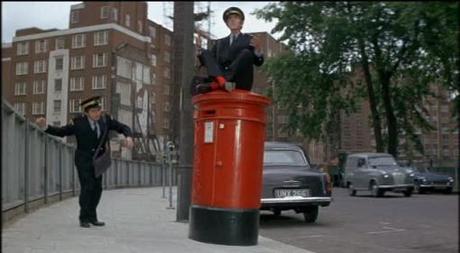
In this one, George grants Stanley seven wishes before he comes to claim his soul. Henceforth, let it be known that the Devil drives a hard bargain: woe befalls the individual who takes Satan — or George, in this case — at his word.
Evil intent and perfidious arrangements with the Heavenly Host or the satanic forces are part and parcel of the genre. But never was a bargain more passionate (and, therefore, more battered and bloodied) than Prince Vlad’s renunciation of God after the premature death of his wife Elizabeta (Winona Ryder), in the prologue to Francis Ford Coppola’s Bram Stoker’s Dracula (whose Dracula movie was this, anyway?).
This sequence, which got the otherwise plodding production off to a rollicking, riveting start, was actually filmed by Coppola’s son Roman, who was in charge of the in-camera special effects.
It was narrated by Sir Anthony Hopkins, who plays vampire hunter Professor Van Helsing in the main section as well as one of the Eastern Orthodox priests in this tantalizing tidbit. Hopkins relates a back story concerning the Moslem Turks’ invasion of the Carpathian Mountains; how Prince Vlad (Gary Oldman) repelled the invaders through his own bloodthirsty methods (not for nothing did he become known as “Vlad the Impaler”); and who, upon his return to his fortress castle, was told of his beloved’s suicide through the spreading of false rumors of his own demise.
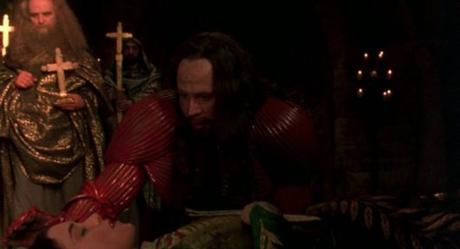
Angry at what he perceived to be the Lord’s betrayal of his most steadfast defender, Prince Vlad renounces God and religion and vows to rise from the ashes of his death by feasting on the blood of his enemies. Vlad wields his huge broadsword and stabs the Christian cross with it, out of which blood gushes forth into a cup. Vlad drinks the blood as he intones a mighty roar upon the words: “The blood is the life,” a sacrilegious reversal of the ceremony of the Holy Eucharist.
The Christian symbolism and deliberate association with the crucified Christ return as the film draws to a bloody conclusion. With a large Bowie knife sticking out of his chest, Dracula makes his way back into the castle — to the exact spot where he made his original unholy vow.
Asking why God has forsaken him, Dracula begs Minna Harker (Ryder in a dual role), the wife of one of his victims, to put an end to his suffering and give him peace. Minna complies with his request by plunging the knife deeper into his chest, out his back and into the floor.
At the words, “It is finished,” Dracula draws his last breath, as an unseen heavenly choir intones a mournful sigh of relief. Cue end credits!
(End of Part Two – To be continued….)
Copyright © 2017 by Josmar F. Lopes
Advertisements
